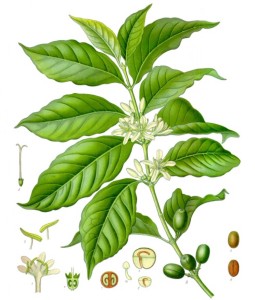— This article by Jerry Cates was first published on 23 October 2015, and revised last on 12 September 2016. © Budsinthenews Vol. 6:10(4).
Coffea arabica is the species, in the genus Coffea, that is the most popular source of the coffee beans used to make the coffee beverage. 75-80% of the world’s coffee production comes from this plant, while about 20% comes from another species, Coffea canephora. Characterized as a small tree, native of the forests of the southwestern highlands of Ethiopia, Coffea arabica was the first species of Coffea to be cultivated.

Caffeine is a bitter, white crystalline purine found in seeds, nuts, and leaves of a number of plants native to South America and East Asia. The best known source of caffeine is the coffee bean, but it may also be present in raw unprocessed cacao beans in concentrations from 0.06-0.4%. Caffeine is chemically similar to theobromine, differing only in having one more methyl group than has theobromine.
Wild Coffea plants grow between 9 and 12 meters (29 and 39 feet) tall, and have shallow root systems. Leaves are opposite, simple, broad, and glossy dark green. White flowers emerge on limbs in axillary clusters, and produce fruits called cherries that take 10-11 months to ripen. Coffee fruits are contained in a drupe 10–15 mm in diameter. They mature as red to purple globes that typically contain two oval seeds — called coffee beans, though they have no relationship with the legumes — that contain 1.5% caffeine compared to 2.7% caffeine contained in the beans produced by C. canephora. It is due to this added caffeine fraction that C. canephora is often referred to as C. robusta.
While on this subject, it must be noted that C. canephora is less susceptible to pests and disease and can be cultivated using much less herbicide and pesticide, is easier to care for, and produces a greater yield than C. arabica. Besides being cheaper to produce, roasted C. canephora beans (commonly called robusta beans) make a strong, earthy-flavored, full-bodied coffee. However, a high pyrazine fraction in the robusta bean adds an offensive aroma and increases its bitterness, so that coffee from C. arabica beans are reputed to have, by comparison, a smooth, less acid taste with a superior, more sophisticated flavor.
Don’t try to sell that to robusta devotees, though. To them, the powerful taste of the harsher robusta beans give it strength, a desirable finish, and — particularly in Italian coffee culture, where in traditional Italian espresso blends high quality robusta beans constitute 10-15% of the grind — a resulting full-bodied taste and thicker foam head (crema) that is greatly prized.
Now, then, let’s get down to business. Coffee is reputed to be chock full of antioxidants. What are they? What do they do? And what do they mean?
With coffee, the answers to the above questions are complicated. Hold on while we put the answers together in a way that is remotely understandable…
Taxonomy:
- Domain: Eukaryota (yew-carr-ee-OH-tah) — from the Greek prefix ευ (yew) = good, well, pleasing + καρυον (khar-yone) = a nut/nucleus, thus organisms whose cells contain a nucleus and other organelles within membranes.
- (unranked): Bikonta Cavalier-Smith, 1993 (bye-KOHN-tuh) — from the Latin bis = twice/double + the Greek κοντος = a punting pole; those eukaryotic organisms within the subgroups Apusozoa, Rhizaria, Excavata, Archaeplastida, or Chromalveolata.
- (unranked): Archaeplastida Adl et al., 2005 (ahr-kee-PLASS-tih-duh) — from the Greek αρχαιος (AHR-kee-ose) = ancient/antiquated + πλασις (PLAS-iss) = a moulding + Anglo Saxon tid = time; a major group of eukaryotes, comprised of the red algae (Rhodophyta), the green algae, and the land plants along with the freshwater unicellular algae known as glaucophytes.
- Kingdom/Regnum: Plantae Copeland, 1956 (PLAN-tee) or Viridiplantae Cavalier-Smith, 1881 (veer-id-eye-PLAN-tee) — from the Latin planta = a green twig; the plant kingdom, consisting of multi-cellular green plants, i.e., whose cells have cellulose within their cell walls and have primary chloroplasts derived from endosymbiosis with cyanobacteria containing chlorophylls a and b and lack phycobilins..
- (unranked): Streptophyta Jeffrey 1967 (strepp-toh-PHY-tuh) — from στρεπτος (STREP-tose) = (easily) twisted, pliant + φυτον (PHU-tawn) = a plant/tree; the land plants and the green algal group Charophyta.
- Subkingdom: Embryophyta Engler, 1892 (imm-bree-oh-FYE-tuh) — from the Greek εμβρυον (EMM-bree-yon) + φυτον (PHU-tawn) = a plant/tree; green plants, informally known as land plants because most are terrestrial rather than aquatic, while the related green algae are primarily aquatic;
- (unranked): Angiosperms (AN-gee-oh-spurms)/Magnoliophyta Cronquist (mag-NOH-lee-oh-fye-tuh) — from the Greek αγγειον (AUGG-ee-awn) = a vessel/pail/reservoir + σπερμα (SPUR-mah) = a seed; the flowering plants, distinguished from the gymnosperms by having flowers, endosperm within the seeds, and the production of fruits that contain the seeds;
- (unranked): Eudicots (YEW-dee-kotts) — from the Greek prefix ευ (yew) = good, well, pleasing + δι (die/dee) = two/double + κοτυληδων (cott-ee-LEE-dun) = a cup-shaped hollow; a monophyletic clade of flowering plants previously known as tricolpates or non-magnoliid dicots, to emphasize the evolutionary divergence of tricolpat dicots from earlier, less specialized dicots; close relationships are presumed among flowering plants with tricolpate pollen grains (the grains have three colpi, or elongated apertures or furrows in the pollen grain paralleling the polar axis);
- (unranked): Asterids (ASS-tur-iddz) — from the Greek αστηρ (ASS-turr) = a star/meteor + the Latin suffix -idus (EE-duss) = indicative of having the nature of; one of the two most species group of eudicots (which have inflorescences having the appearance of a meteor or shooting star), the other being the rosids;
- Order: Gentianales Juss. ex Bercht. & J. Presl (jenn-shun-AHL-ees) — flowering plants in five families, comprised of more than 16,000 species in 1,138 genera;
- Family: Rubiaceae Juss. (roo-bee-AY-suh-ee) — the coffee, madder, or bedstraw family of terrestrial trees, shrubs, lianas, or herbs in three subfamilies comprising some 13,000 species in 611 genera, having simple, opposite leaves with interpetiolar stipules, fruits in the forms of berries, capsules, drupes, or schizocarps
- Subfamily: Ixoroideae (icks-ROY-duh-ee) — from the Greek ιξωδης (icks-OH-dees) = sticky/clammy; a subfamily of morphologically diverse flowering plants within the Rubiaceae, comprised of 24 tribes and some 4,000 species;
- Tribe: Coffeeae (KOFF-ay-ee) — a tribe of flowering plants in the Ixoroideae subfamily comprised of 303 species in 11 genera;
- Genus: Coffea L. (koff-EE-uh) — from the Greek κοφινος (KOFF-in-os) = a basket; a genus of flowering plants comprised of some 129 species, whose edible red or purple fruits, that appear as drupes but are epigynous berries called cherries, contain two seeds, generally known as coffee beans; the coffee beans are used to make the beverage coffee;
- Type Species: C. arabica L. (uh-RAH-buh-cah) — one of the most popular species of coffee-bean producing plants, indigenous to the southwestern highland forests of Ethiopia and the mountainous regions of Yemen, and believed to be the first species of coffee cultivated for its fruit;
References:
- Gichimu, Bernard M. et al. 2014. Biochemical Composition Within Coffea arabica cv. Ruiru 11 and Its Relationship With Cup Quality. Journal of Food Research; Vol. 3, No. 3
- Nuhu, Abdulmumin A. 2014. Bioactive Micronutrients in Coffee: Recent Analytical Approaches for Characterization and Quantification. ISRN Nutrition, Volume 2014 (2014), Article ID 384230
- Oestreich-Janzen, S. 2010. Chemistry of Coffee. Elsevier Ltd.
—Feel free to e-mail jerry.cates@entomobiotics.com regarding your comments on this article. You may also register, log in, and leave a detailed comment in the space provided below.
